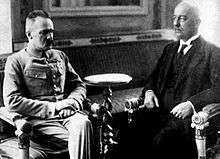Samogitian nobility

Gabriel Narutowicz and Józef Piłsudski are among the best-known 20th century descendants of the Samogitian nobility
The term Samogitian nobility refers to the noble class living in the region of Samogitia, in Lithuania and an integral part of Lithuanian nobility. Historically, the local Polish-Lithuanian gentry was formed of people of various ethnic backgrounds, including Lithuanian, Polish, Tartar, German and Ruthenian.[1]
As the Duchy of Samogitia maintained a certain level of autonomy within the Polish-Lithuanian Commonwealth,[2] its nobility was considered a separate subject of the laws, on par with the nobility of other lands of the Commonwealth.[3]
Samogitian nobility, especially the lower class of it, preserved very well the knowledge of the Lithuanian language and the (Samogitian dialect).[4]
Notes and references
- In-line:
- ↑ Janusz Tazbir (2000). "Szlachta a teologowie". Państwo bez stosów i inne szkice (in Polish). Kraków: Universitas. p. 393. ISBN 83-7052-751-5., also published in English as: Janusz Tazbir; Alexander T. Jordan (1973). A State Without Stakes. New York: Kościuszko Foundation. p. 232. doi:10.2307/2497261. ISBN 0-8057-6137-3.
- ↑ Simas Suziedielis (1999). "Samogitia". Postilla 400. The State Committee for theCommemoration of the 400th Anniversary of the Postile. Retrieved 2007-10-31.
- ↑ Włodzimierz Budka (1921). "Kto podpisał Konfederację Warszawską 1573 r.?". Reformacja w Polsce (in Polish). 1 (4): 314–319.
- ↑ Aleksandravičius, Egidijus; Antanas Kulakauskas (1996). Carų valdžioje. Vilnius: Baltos lankos. ISBN 9986-403-69-3.
This article is issued from Wikipedia - version of the 5/2/2015. The text is available under the Creative Commons Attribution/Share Alike but additional terms may apply for the media files.